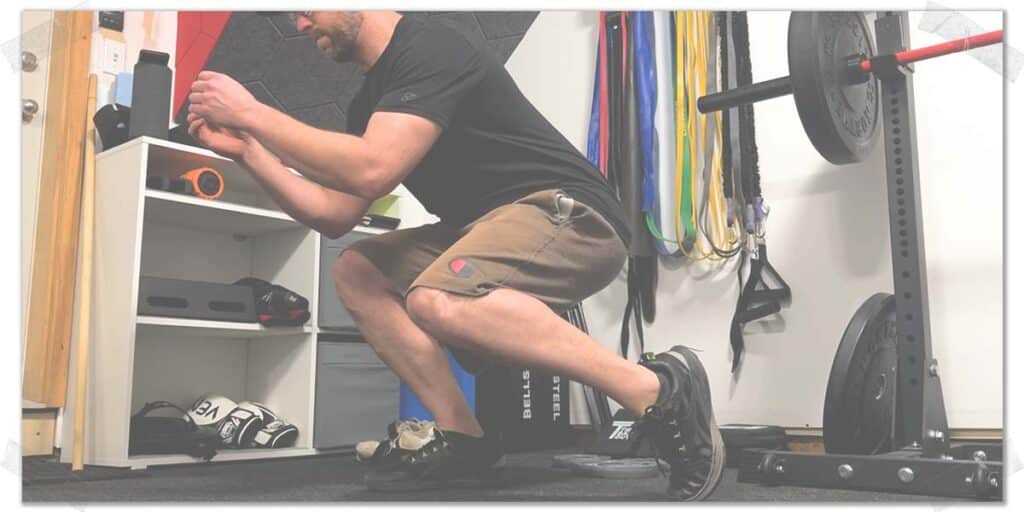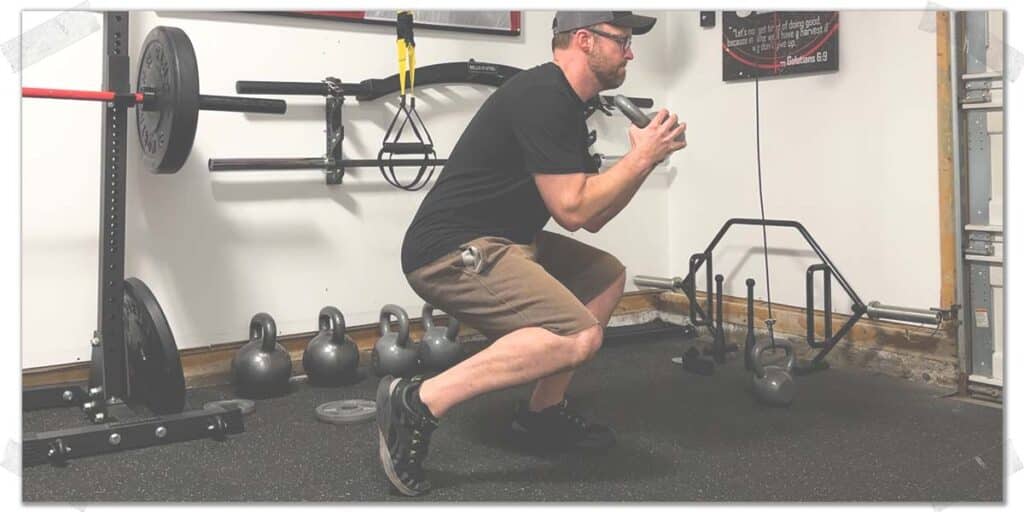What if you could get stronger, more muscular legs using a particular type of leg exercise often overlooked by beginners and experts? And what if this type of movement not only protected your lower body from all-too-common aches and pains in your hips and lower back but also didn’t require fancy gym equipment or tons of heavy weight?
Well, that’s what can happen with the kickstand squat, so maybe we should talk about it.
The kickstand squat (also known as the B-stance squat) can be a highly effective lower-body strengthening exercise for those who have physical limitations such as hip immobility or poor balance. Its modified stance is an outstanding alternative to traditional single-leg training exercises that may therefore be too aggressive or demanding for certain individuals.
Sure, there are plenty of outstanding, well-known exercises that can build a robust set of hips and thighs, but this one, in particular, has a unique benefit that’s hard to find in other lower-body exercises. In that regard, it’s something worth talking about…you know…assuming you want your hip and leg muscles to be bulletproof against annoying aches and pains.
Which, as far as I’m concerned, should be a priority for anyone who wants to get stronger. I mean, what’s the point of being strong if you’re riddled with chronic pain?
So, let’s run through the kickstand squat.

A small request: If you find this article to be helpful, or you appreciate any of the content on my site, please consider sharing it on social media and with your friends to help spread the word—it’s truly appreciated!
Why & How: The Case For Kickstand Squats

Whether you don’t have any physical limitations or you’re plagued by issues that make standing single-leg strengthening exercises a bit tricky or painful, there’s a case that can be made for incorporating kickstand squats into your lower-body training.
This movement may seem unconventional to some, but it’s immensely beneficial to almost anyone looking to find effective ways to build a stronger lower body through squat-based exercises. Not only does this movement light up your leg muscles, making them bigger and stronger, but it also targets some critical hip muscles in a way that double-leg squats typically don’t.
Terminology tip: Remember, the kickstand squat is also commonly called the B-stance squat.
To break things down a bit more, the case for this exercise can be made not only for healthy populations but also for those with physical limitations that make performing heavy double-leg exercises or single-leg stance exercises too challenging or unsafe.
This can include such populations as:
- Those experiencing joint pain when loading very heavy
- Those with hip mobility issues
- Individuals with balance issues
“While Bulgarian split squats are arguably one of the best lower-body exercises of all time, they’re not for everyone, particularly those with limited hip mobility or poor balance. Sometimes, we need an intermediate.”
Naturally, you might be wondering why these populations shouldn’t simply opt for completely different lower-body strengthening exercises altogether. While there can always be a case for doing so, in one of the following sections, I’ll explain why doing so might not always be ideal or practical.
But first, let’s run through how to set up and perform the kickstand or B-stance squat.
Related article: Bulgarian Split Squat Benefits (Are You Missing Out?) | Make Gains!
How to: Performing the Kickstand or B-stance Squat

The exercise is profoundly simple; place your non-weight-bearing leg behind you at a 45-degree angle out to the side and rest it on the ground only enough that it prevents you from falling over – just like a kickstand on a bike.
If positioned correctly, you’ll feel your front leg have to load against essentially all of your body weight before you even squat. Your quadriceps, glute max, and deep hip stabilizers will be primed for serious stimulation.
The secret sauce to be aware of here is to keep constant tension on your front leg at all times, which is pretty easy to do so long as you don’t shift any of your weight onto your back foot. Try not to take a break at any point until you’ve completed all of your repetitions.
This exercise is simple. It’s effective. It gets you stronger. And it prevents injuries in ways that traditional double-leg squats don’t.
That makes for a hard combination to beat.
Exercise Parameters: How many sets, repetitions, etc.?

When it comes to determining sets, reps, etc., with this stance, simply keep all of these parameters in line with your regular training parameters and what feels best for you and your goals. The kickstand or B-stance squat is nothing special in terms of how it factors into your training other than it being an alternative stance to play around with.
Kickstand Squats vs Bulgarian Split Squats
Now, I can already hear a few of you here saying, “Jim, just do Bulgarian split squats instead!” I’m way ahead of you here; I’ve already crafted an article here on my site regarding the benefits of Bulgarian Split Squats, which anyone without balance issues, joint limitations, or muscular weakness should look at. But, we need to keep something in mind here…
While Bulgarian split squats are arguably one of the best lower-body exercises of all time, they’re not for everyone, particularly those with limited hip mobility or poor balance. Sometimes, we need an intermediate.
In the same way, one dietary regimen that’s perfect for one individual might be horrible for another. So, too, is the case with strength training exercises; an exercise that’s brilliant for one person might not be too ideal or downright terrible for the next.
Additionally, while various similar exercises can be performed using specific pieces of fitness equipment, not everyone has access to their own equipment or a gym facility to do this.
Single-leg exercises: The need for options

We need options. While this is true for any type of exercise, it’s critical for single-leg training.
Why? Single-leg training will absolutely save your hips and potentially your lower back from a world of annoying aches and pains that can really interfere with your physical performance and even your daily life.
You see, single-leg training or exercises are profoundly beneficial not only for challenging your quadriceps muscles but also for developing strength and endurance for your deep hip stabilizer muscles. All too often, in life, these muscles become weak, underactive, and unhealthy due to lifestyle factors such as prolonged sitting and a lack of physical activity.
There are numerous deep hip stabilizers to be aware of here, but for the sake of this blog article, I’m mainly referencing the glute medius and glute minimus — two critical muscles that are often dysfunctional and wreak havoc on hip and lower back health.
Other Helpful non-traditional hip & leg exercises
Speaking of which, I’ve got a handful of other articles that have made a tremendous difference for many of my readers suffering from glute medius and glute minimus dysfunction, and it seems it’s been quite helpful, so check out the following articles if you want to get some serious exercise benefit for your hip and thigh muscles:
- Spanish Squats for Healthier Knees | Why | How | Best Practices
- Gluteal Tendinopathy: Here’s A Convenient And Effective Exercise
- The Hip Strengthening Exercise Unlike Any Other (And Why It Works)
I make such a big deal about this because muscular dysfunction in this region of the body:
- is incredibly common (it’s arguably the most common thing I treat in the clinic);
- leads to achy, sore, tender hips, which can become debilitating;
- can easily lead to annoying or nasty lower back pain.
Regarding this last point in particular, you need to remember that while from an anatomical perspective, the hip and lower back are separate areas of the body, from a functional perspective, they’re highly dependent upon one another. And when one area is dysfunctional, the other often gets dragged along for the ride.
Arguably, single-leg training is the best way to signal these deep stabilizer muscles to let them know they need to get their act together. In a single-leg stance, these muscles are forced to activate to an extent they don’t have to when in a double-leg stance.
The alternative for those who (for whatever reasons) can’t perform standing single-leg exercises is to adopt the kickstand or B-stance squat position. It may take a bit of playing around to find the perfect position for your own body, but the benefits can be well worth it if you feel it’s a tactic that ultimately works for you.
Final thoughts
With the kickstand squat or B-stance squat now in your exercise arsenal, you now have one new movement in your exercise arsenal that will allow you to keep on training in ways that challenge the strength of your hip and thigh muscles without needlessly pushing through pain.
So, keep training hard, keep training smart, and keep making great things happen!

Hi! I’m Jim Wittstrom, PT, DPT, CSCS, Pn1.
I am a physical therapist who is passionate about all things pertaining to strength & conditioning, human movement, injury prevention and rehabilitation. I created StrengthResurgence.com in order to help others become stronger and healthier. I also love helping aspiring students and therapists fulfill their dreams of becoming successful in school and within their clinical PT practice. Thanks for checking out my site!

